|

Gill's Historical Index To Gems And Jewelry Online,
Including Journals, Articles and Books From 1652 through today 
This page is rich in photographs, be patient while it loads.
Introduction, by Joseph Gill
Note: The author is doing this introduction to “Gill's Historical Index Online” in the hope that young budding gemologists will be inspired to know that they can, with enough determination, make a major difference in our young science.
I was born on March 2, 1949 in Portland, Oregon and spent the first 20 years of my life in Vancouver, Washington; just across the Columbia River from Portland. My mother, Trudi ‘Osborne’ Gill, was an avid traveler so every summer from 1960 - 1969 I would go with her overseas. We traveled all through Japan, Philippines, Thailand, Taiwan and the rest of SE Asia. Then we went to every country in Central and South America, followed by West and North Africa. We continued on to most every country in Europe. I never met any other travelers in these early days and the world was completely different to what it is as we travel today. While visiting 65 or 70 countries I noticed jewelry stores and thought to maybe go in that business so I could continue traveling as an adult.
My father, Dr. Joseph Howland Gill, MD, an Orthopedic Surgeon in private practice and a senior professor at the University of Oregon Medical School was always interested in learning new things. He took a course in geology and asked me to go sit in on his classes and that became a first love for me. I went to The Oregon Museum of Science and Industry, OMSI for 3 weeks at Camp Hancock in eastern Oregon during 2 summer sessions, where we studied geology. I graduated with a B.Sc. in 1970 from Portland State University in both Geology and Physical Geography. Then I took a job for one year at Fox’s Gem Shop, a fine jewelry store in Seattle. I started the GIA home courses while in Seattle and that is when I started a mad passion for collecting all books and publications in English on every aspect of gems and jewelry. I then moved from Seattle to Denver in 1972 where I took some graduate courses in geology at Colorado School of Mines. I was doing a lot of research at the US Geological Survey nearby and there learned about the Gemological Association of Great Britain and it’s very coveted degree F.G.A.. Usually it is a 2 year intense course, where one in five people who take the exams manage to pass. Because of my geology background I talked them into letting me take only the second year and challenging the first year exam without taking the actual course and they said OK. So I took the GIA final exams and the two British exams over a consecutive three days, at the USGS Library with a professor acting as proctor. I received my GIA “Gemologist” degree dated Aug. 23, 1973 and my British degree “Fellow of the Gemmological Association of Great Britain” or F.G.A. dated Nov.19, 1973. Later in 1975 the American Gem Society AGS gave me the “Certified Gemologist” degree.
Working for J. & S.S. DeYoung's in Boston as their head gemologist from 1974 - 1980

Who's Who - 1979


I am and always have been an information collector. I did my “Gill’s Index” for the GIA in the 1970s, with the encouragement of Dick Liddicoat President of the GIA among others, as a labor of love.
I was working for J. & S.S. DeYoung's in Boston as their gemologist from 1974 - 1980. I helped make the single biggest sale in the history of this firm to the King of Saudi Arabia, by providing an extensive provenance from my personal library on gems and jewelry with some 65 pages of documentation of ALL references in the English language. Both the Nassak Diamond 43.38 carats with GIA NY Certificate #23998 “D” “internally Flawless” bought in mid 1976 & a unique Gem Burmese Ruby of 35.22 carats bought in 1978 with GIA NY Certificate #141093 (soon re-polished to 34.25 carats) were extensively documented with all records coming from my personal library at my home. These leather bound documents were done by me without any request from DeYoungs, as an effort from their new young 24 years old gemologist to show them what I was capable of producing. As the firm’s European salesman explained twice after this sale was completed, to all those at DeYoung’s, “the King had seen the stones before from our business partner and was not impressed. When shown both gems on the second showing he was also given the 2 leather bound volumes of extensive research on them. He read them for half an hour and then agreed to purchase both these fine gems”. I not only did not receive any commission for my critical part in this record making sale but not so much as a thanks or that was a good job. See the article by David Federman, editor of “Modern Jeweler” on this sale and other interesting background, reproduced below. As Richard T. Liddicoat says in the foreword of “MODERN JEWELER'S GEM PROFILE, THE FIRST 60”, 1988, by David Federman, "No one investigates a subject in more depth than Mr. Federman and no one writes with greater clarity on the matters that he studies so assiduously." (see, GEMS & GEMOLOGY, Fall 1988, Book Reviews, p. 191 -192 and GEMS & GEMOLOGY, Spring 2002, “Richard T. Liddicoat, The Ultimate Gemologist”, By Dona M. Dirlam, pp. 2 - 13). For the 24 years since this article was first widely circulated there has not been one serious objection as to accuracy of any of the statements related therein. I did learn much from this significant experience about the importance of good research and establishing an extensive provenance on historic gems and jewels. Bob Crowningshield, Vice President of GIA & head of the GIA labs in NYC, called me in early 1980 as a last resort, concerning the famous “The Crown of the Andes”. I happily supplied him with not only extensive documentation but also the current owner’s name (see documents below). Mary Murphy, head gemologist at Christies in NYC called me about the same time, about a piece they had for auction, “The Green Cross” from the Henry Phillip Hope Collection (then owner of the famous “Hope Diamond” that is now in the Smithsonian). I gladly sent Mary the pictures and the original description of this unique green gem. I had taken these pictures from the personal copy of Mr. Henry Thomas Hope’s (signed by him), “Henry Phillip Hope Catalogue” that was published in London in 1838 and this was now in my library (see documents below). Christies used all this in their jewelry sale catalog for Geneva 1980, and I was happy to help them on this matter as well as several other instances.
Modern Jeweler by David Federman, Editor Jan 1985


I had to make private sales to support my gem book collecting habit. I managed to get a library when these books were still cheap and it included ALL the publications and books published in English that John Sinkankas, famous gemstone writer and gem book collector, had and more on gems and jewelry. I stayed at John’s house in San Diego several times and we were close friends since 1968. I was always proud when I visited John Sinkankas at his home in latter years to see my ”Gill’s Index” on a small shelf of books at his desk, where he did all his writing next to his 14,000 book library. The John Sinkankas Library was purchased by the GIA in 1987 and now makes up the core of the entire GIA’s world class library.
I did not know how to type so when I did my index I hand wrote each entry on 5 by 8 inch cards about 4 feet thick of them. Each time I read a new sentence I had to look up the right card to make the annotated entry. After 9 years of work I completed a 420 page book with over 14,000 entries. So you can look up France and find that a rough diamond was found there or what gems were found in Antarctica or California or Nigeria or Ghana or Florida or in the oceans or anywhere including from outer space. You can find all the references ever in English from the first book done by Thomas Nicols on gems in 1652 until 2008, near 350 years of all the publication in English on gems along with more than 18 journals on gems and minerals. I went through each sentence of each publication and all was put in this handwritten annotated index. I did my work in my small apartment with my wife typing out the final draft (an 18 month job). This was only the second book ever published by the GIA that was not done by a member of its own staff. See G & G, Fall 1980 p. 367 - 368 “Where Have All Our Answers Gone” and on p. 368 - 369 “Gill’s Index” reviewed by Dr. Edward Gubelin. Gubelin says “The idea and concept of Gill’s Index should be taken up by other scientific branches of knowledge. After all, the motto for the expert stands: Not the not-knowing is shameful, but the not-knowing where you could look it up”. Dr. Gubelin did seven different very positive reviews of “Gill’s Index” in four languages and called it “a marvelous index”. Dr. Wendell E. Wilson, editor of The Mineralogical Record in his own full review of “Gill’s Index” agrees with Gubelin by saying “Why has such a comprehensive index not been produced for other important areas of study”, and Wilson continues “Gill’s Index represents an enormous labor of love requiring years of work, significant funds, and a degree of motivation beyond most authors”. G & G Summer 1979 p. 190 “GIA Publishes An Essential Gem Book, GILL’S INDEX, this will be updated every few years” and Richard Liddicoat also proclaimed in the G & G “The GIA is proud to announce the publication of “Gill’s Index” as part of a continued effort to keep the jewelry and gem industry informed”. I had the opportunity to talk to Dick Liddicoat at his home via phone three months before his passing and he was most enthusiastic about the idea of putting the “Gill’s Index” on the web as “Gill's Historical Index Online” where interested people, including authors, could continually update it. Winter G & G 1979-1980 p. 250 top right reads “GIA’s latest Reference book”, “information is easy to find with Gill’s Index” (see documents below).
“Gill’s Index” was only the 2nd book ever published by the GIA that was not written by a member of the GIA’s own staff



G & G, Fall 1980 p. 367 – 369



American Gem Society – Guilds Aug-Sept 1979

Lapidary Journal - Dec. 1979




The Mineralogical Record March-April 1981

Yes, I was crazy and poor and naive in my 20’s, but I had my heroes calling and writing me for information regularly like John Sinkankas, Frederick H. Pough, Edward Gubelin, Robert Webster and Basil William Anderson, Vince Manson (who kindly asked me to speak at the 1981 LA GIA Symposium), Robert M. Shipley, A. E. Alexander “Doc”, Richard T. Liddicoat, Robert Crowningshield, George Switzer, Paul Desautels, Clifford Frondel & Cornelius S. Hurlbut at Harvard, Dr. Strong of General Electric and many more (see documents below). You can search “Gill's Historical Index Online” and get detailed information on all these people and several hundred other notable people in the history of Gemology, while you will also find articles authored by them. That was what I enjoyed, not the money. If I had the 4 inch thick file of correspondence from these wonderful people 1964 - 1985 I would have gladly sent it to the GIA Library as memorabilia (SEE G & G, Summer 1977 p. 307, bottom left).
ORIGINS OF GEMOLOGY IN PICTURES by Joseph Gill 1976
- Presented to attendees at the Bicentennial 1976 American Gem Society AGS Conclave held in Boston


Some other Works by Joseph Gill




John Merion, the President of Sotheby’s, NYC called me at DeYoung’s in February 1980 and offered me a directorship over all jewelry sales in the western U.S.A. based in Los Angeles (see documents below). I knew it was time to move on so I stopped collecting books and started collecting gems and jewelry for them. In my first year of unbelievable effort in LA I brought their business up nearly 400 percent from 3.5 million to near 15 million dollars and did 80% of the profit for LA Sotheby’s according to a letter of review from their president.
Joseph Gill Is Asked to Direct Jewelry Sales For Sotheby’s, Over the Western USA




From Boston to Beverly Hills
Notes from the East & West GIA About “Gill’s Index” and Sotheby’s


The First International Gemological Symposium held by the GIA in 1981


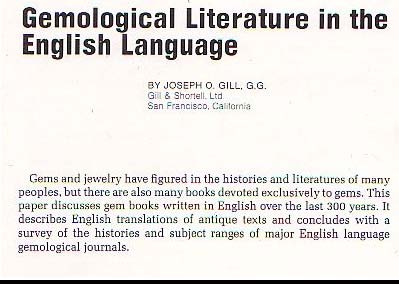
I started my own business in San Francisco, September 6 1981, brokering people’s jewelry and making 10 to 15% commission. I did well from my first month and was VERY happy after earning the first money in my life worth talking about. I saved nearly 90% of what I made, lived in a stylish small apartment and continued to drive my 1976 Honda Civic till 1990. I was out doing it for myself the first time in my life.
Gill & Shortell, Ltd started September 6, 1981 & Retired September 6, 1988
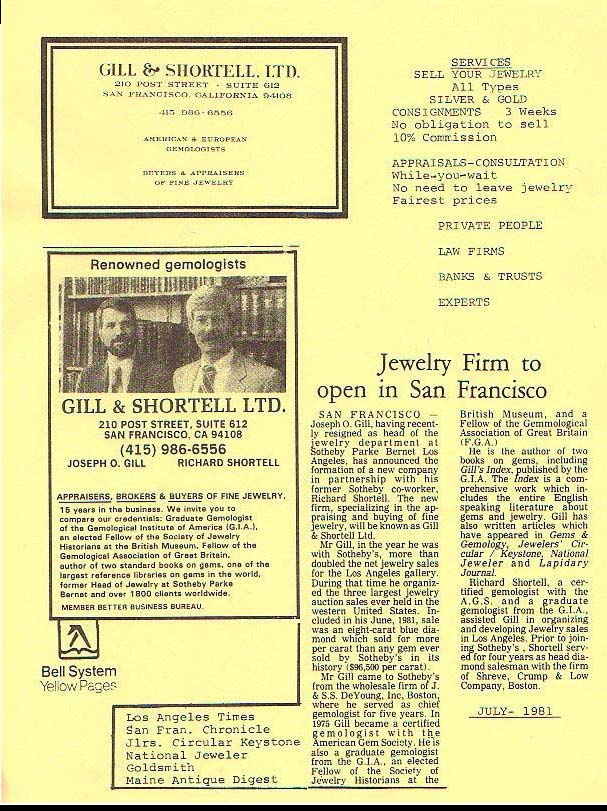
In 1981 Dick Liddicoat called and asked me if I might be interested in heading up the GIA. I told him I was happy working for myself but many thanks for thinking of me.
I sold my extensive gem library via Christies, famous auction house in New York City on Madison Avenue,
"THE GILL COLLECTION OF HISTORICAL GEM BOOKS".
1st sale: Wednesday, October 21, 1987;
2nd sale: Tuesday, December 2, 1987;
3rd sale: Wednesday, April 20, 1988
& the last, 4th and final, single owner sale: Tuesday, June 7 1988.
These book sales were part of Christie’s catalog, “Magnificent Jewelry”, each having sales of over 20 million dollars in jewels and gems (see documents below). The Introduction to this book sale is written by Neil Letson of Anniston, Alabama, a very noted writer for Christies, as well as The Smithsonian Magazine, Connoisseur, The Saturday Evening Post, The Atlantic Monthly, etcetera. This Introduction covers the origins of this unique book collection and is reproduced below. To date, 2009, this is the largest and most important public auction of a book collection on this subject, which has ever been sold, worldwide. The four different Christie’s catalogs entitled, “The Gill Collection of Historical Gem Books”, contain an excellent bibliography of books and publications on the subject of gems, gemology and jewelry in English and are much sought after by collectors.
Christies had difficulties in both their Antique Book Department and Jewelry Department to find someone qualified to actually do the cataloging and pricing. With my own background at auction with Sotheby's and an expert on the books in my own collection it was decided I was the most qualified. For the first time that I know, since Christies origins in the early 1700's, the consigner did both catalogue and put price estimates. I did this for the entire four catalogues.
“The Gill Collection of Historical Gem Books”

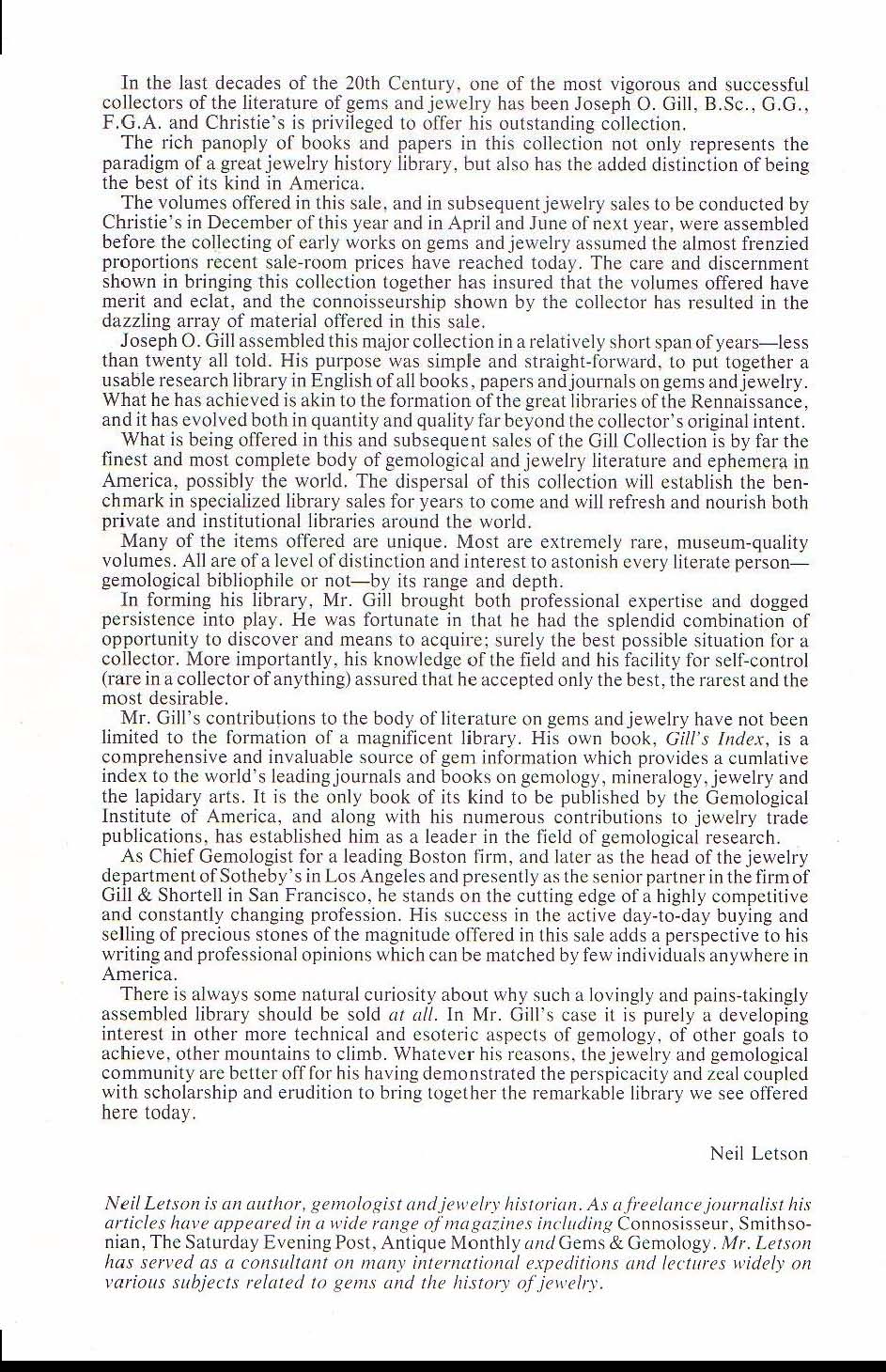
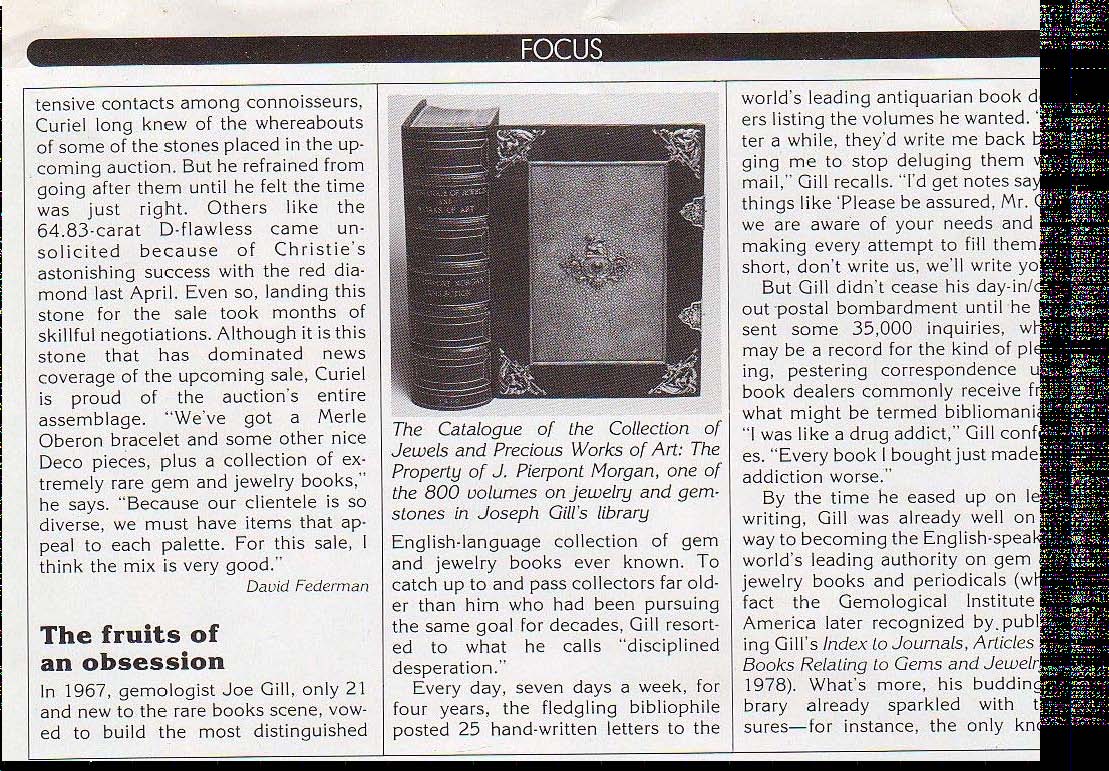
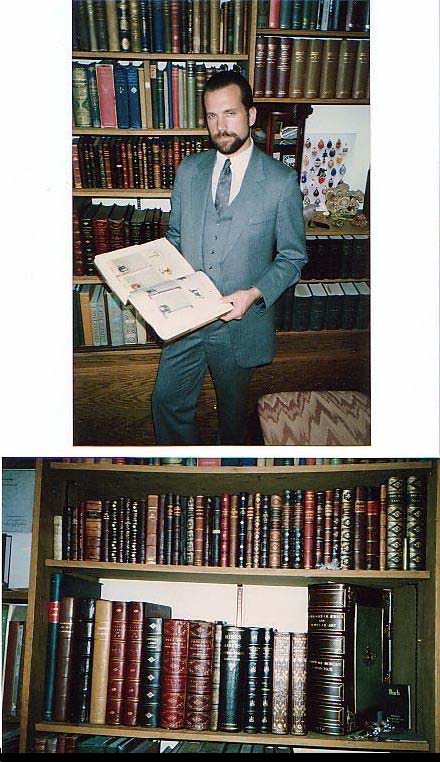
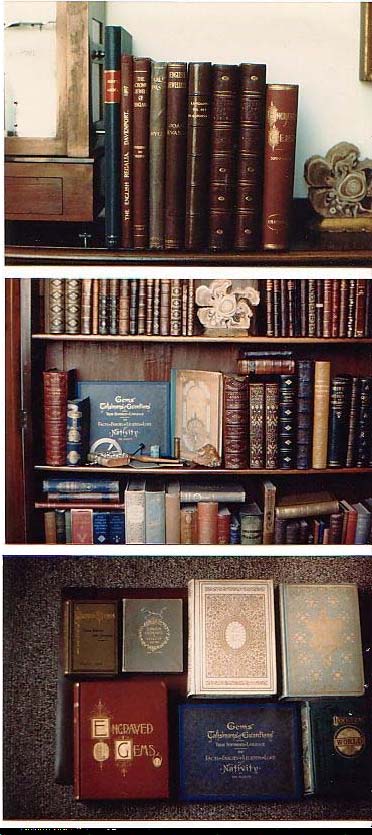
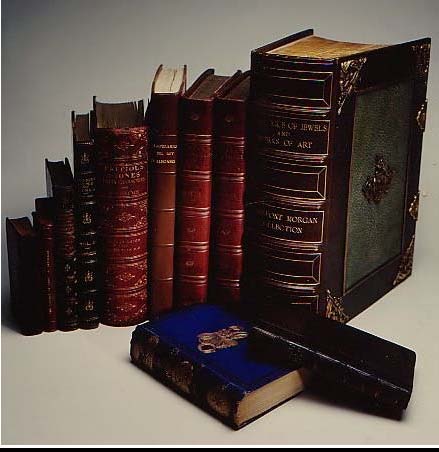
1910, Catalogue of the Collection of Jewels and Precious Works of Art, the Property of James Pierpont Morgan, by G. C. Williamson, London, 183pp.
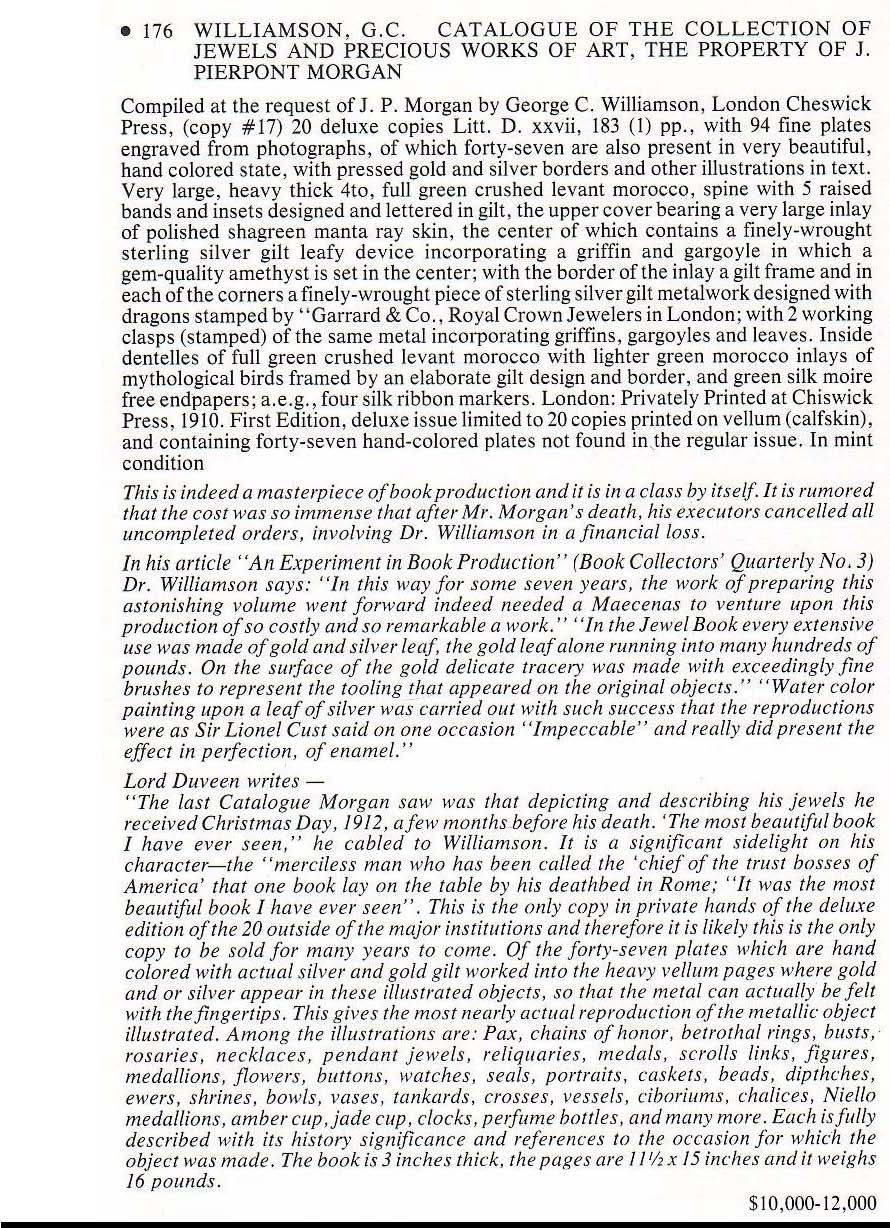
1839, A Catalogue of the Collection of Pearls and Precious Stones Formed by H. P. Hope, by Bram Hertz, London, 112pp.

The Six Voyages of Jean Baptiste Tavernier, Baron of Aubonne, Through Turkey into Persia and the East Indies For a Space of Forty Years,1677,
first English edition by John Phillips, pub. Dr. Daniel Cox, London.
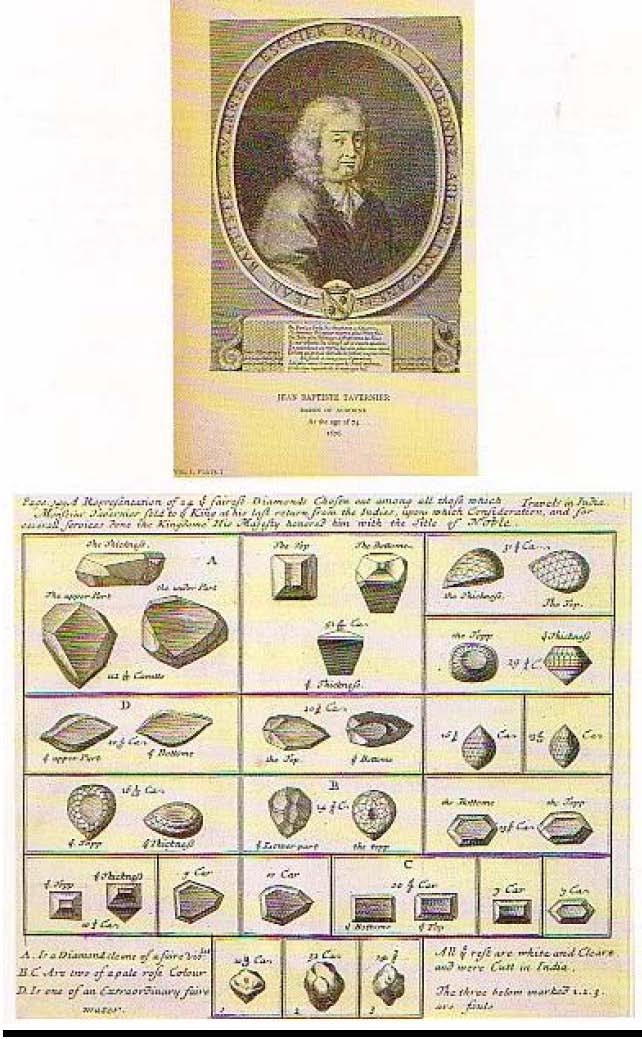
1813, A Treatise on Diamonds and Precious Stones, Including their history-natural and commercial, by John Mawe, London, 166pp.

On September 6 1988, seven years to the day from starting my own business, at the age of 39, I closed the doors and that was that.
One year later, on September 6 1989, I moved to the big island of Hawaii and lived there from 1989 till 2003. I then sold my house, which I had built myself, and my new wife Nancy and I started an extended trip overseas. We have been traveling over 6 years now and you can read about our adventures each month at
www.worldglobetrotters.com .
Joseph Gill today in his 6th year of continuous travel overseas, (2003- ) on a 25 year adventure.
See more about this at www.worldglobetrotters.com
Joseph in Tibet

Papua New Guinea
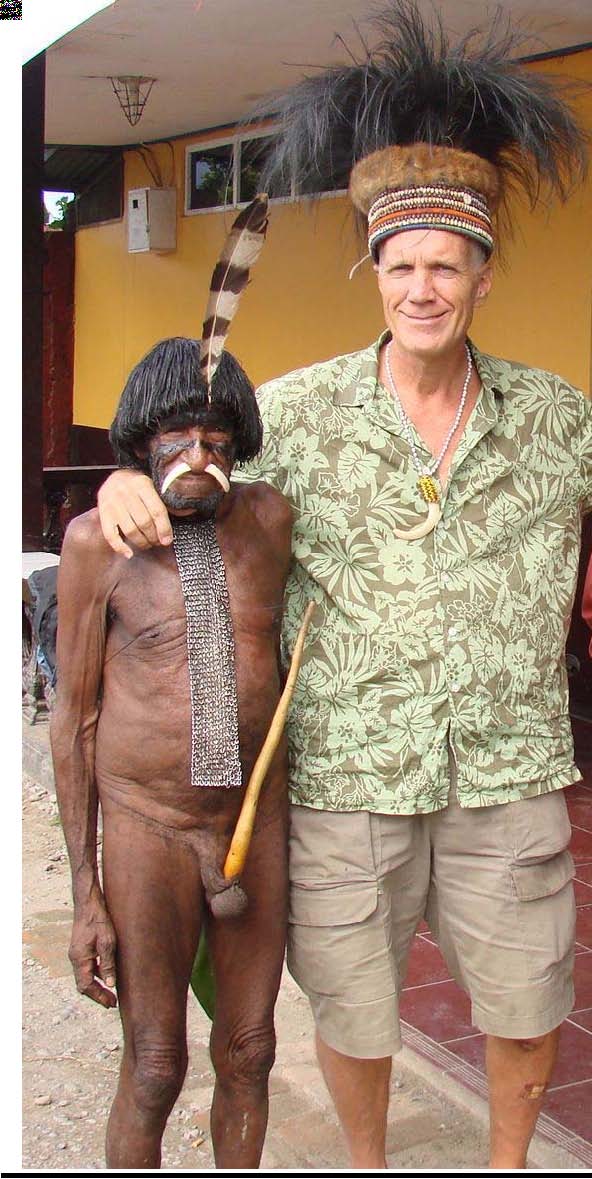
Sumatra Orangutan
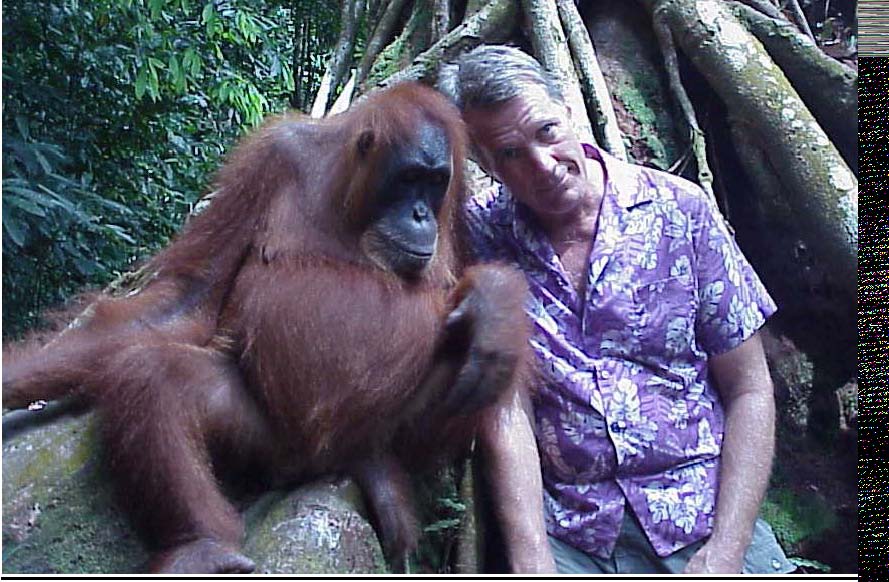
Gobi Desert in Western China
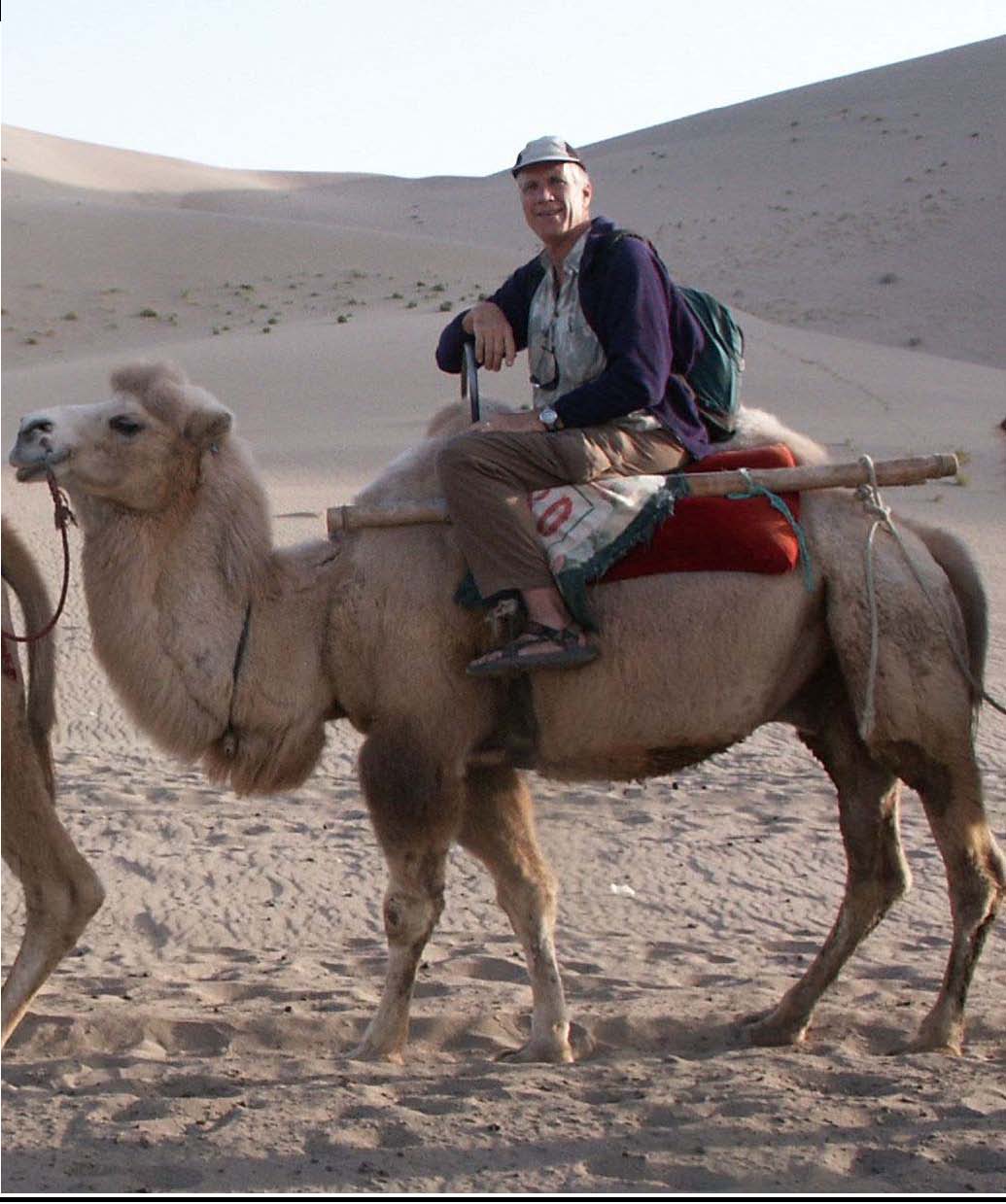
Joseph and Nancy on their 25 year adventure 2007
Two healthy vegans at dinner
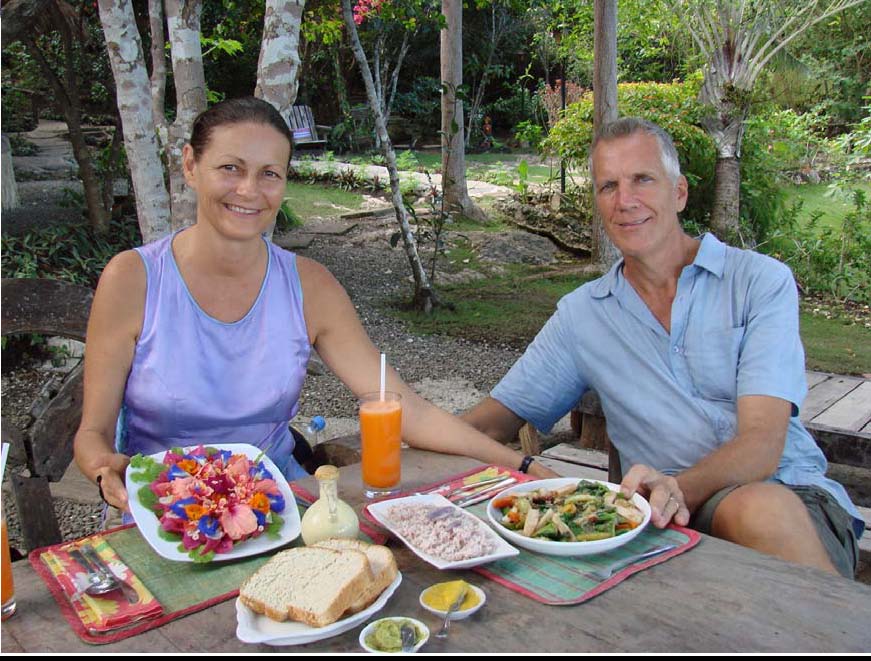
I hope you have enjoyed the diverse documentation and story covering the evolution of “Gills Index”; and on my work history included herein. I hope that this autobiography will show young gemology students that when you have enough persistence and a love for your subject, the only limits you will have are those that you make for yourself. This idea has been a central part of my life and it has never failed me. I will not be coming back into the gem business but am confident that my contributions will live on with “Gill's Historical Index Online”.
I am freely offering to resurrect “Gill’s Index” into “Gill's Historical Index Online” a much more useable electronic media that can be updated as time moves on. “Gill's Historical Index Online”, is a complete ‘redo’ effort of the much harder to use printed “Gill’s Index”. The index has been updated as much as possible with resources that were made available to me via the internet, while traveling overseas. Anyone wanting to help update any part of this index is asked by the author to please contact me offering your ideas or help. You may choose to make updates for any of the separate journals, or a special gem or locality. If you see any glaring errors in the texts or missing books, don’t panic, just send me an email and then you can be helping in this project. I have already done the first 350 years of this effort.
It is good to remember that “Gill’s Index” was originally a GIA publication, following Richard Liddicoat’s passionate ideals, when he proclaimed in the G & G “The GIA is proud to announce the publication of “Gill’s Index” as part of a continued effort to keep the jewelry and gem industry informed”.
The “Gill's Historical Index Online” is easily and instantly searchable (ctrl + F) for any gem writer, teacher, gemology student or interested newcomer. Search for any name, key word, famous gems, year, or whatever you desire. Read the first part of “Gill's Historical Index Online” to learn more about how to use it and its origin’s.
The “Gill's Historical Index Online” is easily downloaded with a total size of 8 megabytes and totally useable off line.
I would invite any of your questions or comments.
A Fellow Gemologist
Joseph O. Gill, BSC, GG, FGA
Email: gilljoseph1949@yahoo.com
Website: www.worldglobetrotters.com
|
|
To the library:
Chronologically »
Here you find the directory arranged chronologically based on century and then by title.
By Topic »
Here, the same directory arranged by topic and then by title.
Links to copyrighted material »
Some of the material collected by Joseph Gill is still under Copyright law and is therefore not downloadable. The publications that can be found for purchase or reading online are linked to from here.
|